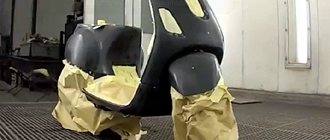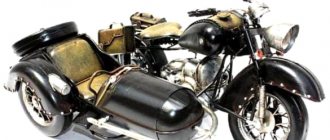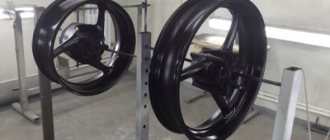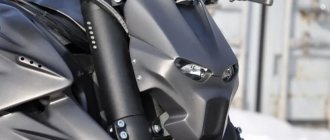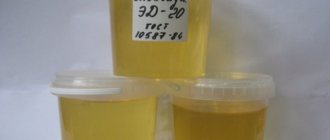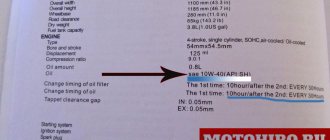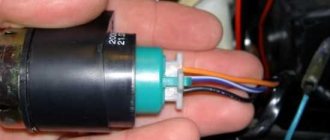Today, each of us, sooner or later, is faced with the need to paint some plastic parts. After all, we are surrounded by many things made of this material: in modern cars, motorcycles and scooters, the number of plastic parts is constantly increasing. The technology of painting plastic has its own characteristics and nuances. This is due to certain properties of this material: it is quite elastic and paint does not adhere well to its surface. Also, the behavior of plastic when coated with paintwork materials depends on the type of plastic. Today, there are a variety of means for coloring this material, so repairing car plastic parts is not a problem.
Painting plastic
The type of material is always indicated in the markings on the inside of the part, so before you start painting, carefully study this abbreviation.
Types and properties of plastics
Plastics are materials with a polymer base. Due to the content of various plasticizers, stabilizers and other fillers, plastic is endowed with good properties of fluidity, ductility, strength, etc. There is a classification of plastic according to the following criteria:
- Chemical composition.
- Rigidity.
- Fat content.
But, perhaps, the main criterion for the characteristics of this material is how the plastic behaves when heated. Based on this property, the following types are distinguished:
- Thermoplastics are plastics that melt when heated and return to their original state when cooled. Thanks to this property, such parts can be welded and soldered. This type of material is the most used for the production of car parts: panels, bumpers, radiator grilles, wheel caps, etc.
| Designation | Decoding |
| RR | polypropylene |
| PVC | polyvinyl chloride |
| PS | polystyrene |
| P.E. | polyethylene |
| PA | polyamide |
| PC | polycarbonade |
| PVA | polyvinyl acetate |
- thermosets are materials that become soft when heated only once - during the formation of the part, but remain hard during subsequent heating. They cannot be welded or soldered, otherwise the material will simply collapse. Thermoset plastics are heat-resistant, so they are used for the production of hoods, trunk lids, fenders, etc.
- Elastomers are plastics that are highly elastic. When loaded, it bends, and when it is removed, it returns to its original shape. The main advantage of this type of material is that even at very high temperatures they remain elastic. Tires, seals, etc. are made from it.
Choosing high-quality paint for car interior parts
Selecting suitable materials is one of the most difficult stages of completing a job. If you have never dealt with car paint issues, restoring plastic will be a rather complicated process for you. A car needs a professional approach at every stage, including when choosing products. You won't need a primer for salon elements, but specialized materials for painting will come in handy. You need to pay attention to the following points:
- special purpose for plastic - products can be used for car bumpers;
- the ability to paint structural surfaces, which is inherent in all auto paints for such tasks;
- manufacturer - choose well-known companies such as Motip or KUDO, you can use Polish Farbid;
- price - if the cost is too low, there is a possibility of purchasing a fake instead of the original;
- packaging form - the easiest way to work with aerosol options, since they do not require a compressor.
It is also worth acquiring rags, solvent and thinking about devices for hanging or laying plastic parts when applying paint and varnish products. Take care of everything in advance so that you don’t have to run around looking for scrap materials around the car when work begins. It is best to paint the interior elements of your car with products with a quality guarantee. In the store, when purchasing, you can ask for documents for the goods.
Determining the need to prime the plastic
Before painting, plastic parts often need to be treated with a primer. Often, but not always. It all depends on what type of plastic this element is made of. It won’t be difficult to determine this at home; all you need is matches or a lighter. With their help, we need to set fire to a small area of the product.
If the combustion process is accompanied by soot, then priming is not necessary. Another life hack - the part needs to be immersed in a container of water, and if it floats up, then no primer is needed.
Advice for car enthusiasts
If you have made the final decision to paint the plastic, then you should prepare for such work in advance.
- Choose a fairly spacious and well-ventilated room.
- Buy special work clothes, gloves, a respirator and safety glasses.
- Buy the necessary materials and tools.
- Prepare old newspapers or other material on which you can paint and then dry individual parts.
- Study all instructions written on the packages of materials.
- Try to read all technical documentation in detail.
- During your first attempts, do not strive for extreme tuning.
- Do not paint material that looks like plastic but is not.
- To update your design, choose more pleasant tones.
If you can take the painting task responsibly and seriously, then you will succeed!
Stages of painting plastic machine elements
Before you start painting, you need to prepare all the tools and materials necessary for the job:
- dye;
- solvent or white spirit;
- acrylic varnish;
- soil for plaza;
- abrasive sandpaper for cleaning.
Next, after dismantling, we move directly to the part.
- We clean the surface with an abrasive cloth to get rid of small irregularities.
- We treat with a degreaser - in our case we use solvent or white spirit.
- We use an antistatic agent to prevent dust from settling on the surface.
- If there are significant irregularities, we putty the defects and clean them. We use a special putty for plastic.
- Degrease the base again.
- Apply primer - 2-3 layers and leave the coating to dry - this usually takes about 1 hour.
- Apply 2 or 3 thin layers of acrylic paint using a paint brush or spray can. This composition is ideally suited for coloring plastic. And leave to dry for 30 minutes.
- We coat the surface with varnish.
- Apply paste to polish the surface.
Tip: It is better to apply paint from a spray can, this will significantly reduce the consumption of material, unlike painting with a brush. But if you have to work with a brush, then expect that such a coating will take 20-25 minutes longer to dry.
DIY materials for painting plastic
Primer for plastic
Painting a plastic car requires at least a special primer and putty for plastic. But if we are painting old surfaces, then it will be enough to matte the surface with sandpaper, and there is no need to apply primer. In practice, the entire procedure is quite simple.
There are two main types of plastic used by the automotive industry today. The first does not require careful preparation and preliminary priming. The second one is the opposite. They are quite easy to recognize and distinguish from each other in practice. There are two simple methods, which involve buoyancy and combustion of the material. When you place a small piece of plastic in water, it will either sink (in which case there is no need to prime) or remain afloat (in which case it is necessary to prime). Plastic also needs to be primed if it burns with a clean flame, but if it smokes, there is no need to prime it.
When painting plastic elements, it is very convenient to use paint in an aerosol can. Please note that a garage or small workshop is not particularly suitable for carrying out such work. The room should be well ventilated, clean and, importantly, free of dust, since it has the nasty property of settling on freshly painted surfaces.
Various plastic painting technologies
There are many different technologies for painting plastic parts of a car with your own hands. Which one to choose depends purely on your desires and taste preferences. Using paint, you can imitate wood coating on a part. This technique is not particularly complicated, but the result is spectacular.
Swirling technique in the interior
The technology for this coloring is as follows:
- After preliminary filling and priming with a brush, apply longitudinal lines with black paint; here and there, holding the brush perpendicularly, we rotate it, thus drawing, as it were, knots.
- Then we clean the coating along the drawn stripes, creating an imitation of a wood structure.
- Next we apply white paint.
- Glue thin strips of tape in random order.
- Use dark brown paint to fill in the gaps between the tape.
- Remove the tape and use brown paint to adjust the design as you see fit.
- If desired, the surface can be varnished.
The Swirling technique is distinguished by its originality and creativity. What is it? Let's try to figure it out.
The point of this coloring is to cover a plastic part with a multi-colored film of paints. To do this, special paint is poured into water and the product is immersed there. In this way, a colored film covers the surface.
This plastic processing option, such as flocking, not only performs a decorative function, but also improves the thermal insulation characteristics of the material. After all, plastic painted in this way cannot be heated. Externally, this finish creates a velvet effect on the surface.
What paint should I use on the interior plastic?
- There is paint designed for plastic. Vinyl paint/dye is suitable for painting car interiors. This paint can also be sold as interior leather paint. In this case, on the can, when listing the surfaces to be painted, “dash panel” may be indicated. Vinyl paint is water-soluble and contains vinyl plastic (PVC) that adheres well to plastic surfaces. Once painted, the paint becomes part of the plastic surface. There are different formulas of this paint designed for specific tasks. Some manufacturers still recommend applying even this paint only after spraying plastic primer (for maximum adhesion).
- In addition to special vinyl paint, car paint can be used to paint plastic interior parts, either in cans or sprayed through a spray gun. A prerequisite will be the spraying of a special plastic primer (adhesion enhancer). We will consider this soil and its application in more detail in this article below. The paint can be selected at an auto enamel store according to the interior color (on modern cars there is a plate with the interior color code).
- If you plan to paint the interior panels, then use a non-glossy paint so that it matches the rest of the interior parts. Glossy paint on large parts (or the entire dashboard) will look cheap and can also create glare that will distract from driving. However, individual small elements may well be glossy and will harmonize well with the rest of the matte part of the interior.
- It is necessary to use paint and varnish on the same base and not mix different types of paintwork, otherwise defects may occur due to incompatibility of the products. Find a manufacturer that offers the full line of products needed to paint interior plastic. This is a special plastic primer, acrylic primer (optional), paint and varnish (optional).
We recommend: Do-it-yourself chip tuning – how to do it right?
Photo gallery of finished works
Let's sum it up
Every car owner wants to make their vehicle more attractive. There are many ways you can implement this noble undertaking. But often methods involving professionals turn out to be too expensive. Therefore, potential customers of paint booths and service stations prefer to buy the necessary paint themselves and do the work themselves. This is much cheaper, but does not always give the desired results. It is important to choose the right methods and tools.
When working with plastic, you should protect the interior as much as possible from enamel and prepare the part for applying auto paint. Also, do not forget that there are quite a few brands on the market offering painting products in a variety of price segments. It is much easier to immediately buy good material and not overpay later for the restoration of poorly painted parts. It will be cheaper and more profitable in all aspects, and the owner of the vehicle will be able to show himself in taking care of his car.
Interior preparation and processing of old paint
The plastic in the car interior needs very high-quality processing. The specificity of painting materials is such that incorrect application will result in drips, color transitions and unpainted parts. All this causes certain difficulties. Interior plastic paint can adhere normally only if the part is first prepared. To do this, a fairly simple procedure is performed with the following procedure:
- The parts are removed from the car. This must be done carefully, as some plastic elements are very easy to damage. If we are talking about the panel and door cards, you can leave them in place, closing everything around.
- If the enamel is applied to a greasy and dirty surface, all the paint material will simply run off. So, to begin with, the plastic is degreased and cleaned of all kinds of contaminants.
- The next step is to sand off the old paint using water and fine-grit sandpaper. Use P 1500-2000 on a waterproof base and constantly feed water under the abrasive.
- Next, the interior is protected from paint getting on all kinds of elements, otherwise you will have to scrub them off later. To do this, use thin masking tape and film or newspapers to create protective screens.
- The last thing you should do is degrease the surface again and apply paint with gentle movements. This will help to quite easily maintain the evenness and quality of the plastic surface and restore freshness to the interior.
In order for the car to become beautiful again, you must apply the purchased materials efficiently and without errors during the work process. Otherwise, the paint will run off, will not dry, or will be very different in color. Remember also that when painting local plastic parts you will have to use the transition painting method. This is not possible using a spray can; professional equipment will be required. Interior plastic paint is sold not only in aerosol form, but this is the most convenient way to use it.
Adhesion promoter
p, blockquote 11,0,0,1,0 —>
- The formula of the adhesion enhancer may vary from manufacturer to manufacturer. The basis of such primers are strong solvents that “open the pores” on the plastic surface for better spreading and adhesion of paint. An adhesion promoter not only changes the surface properties of the plastic, but its additives can act as a glue between the plastic and the paint.
- The adhesion enhancer (primer for plastic) should be sprayed at a distance of 30 cm from the surface. Apply a thin layer. Spraying too much of an adhesion promoter can, on the contrary, cause problems with paint adhesion.
- It is always best to research how to apply an adhesion promoter to containers.
- The duration of action of special primers that increase adhesion may vary. Some manufacturers even guarantee action for 24 hours after application.


